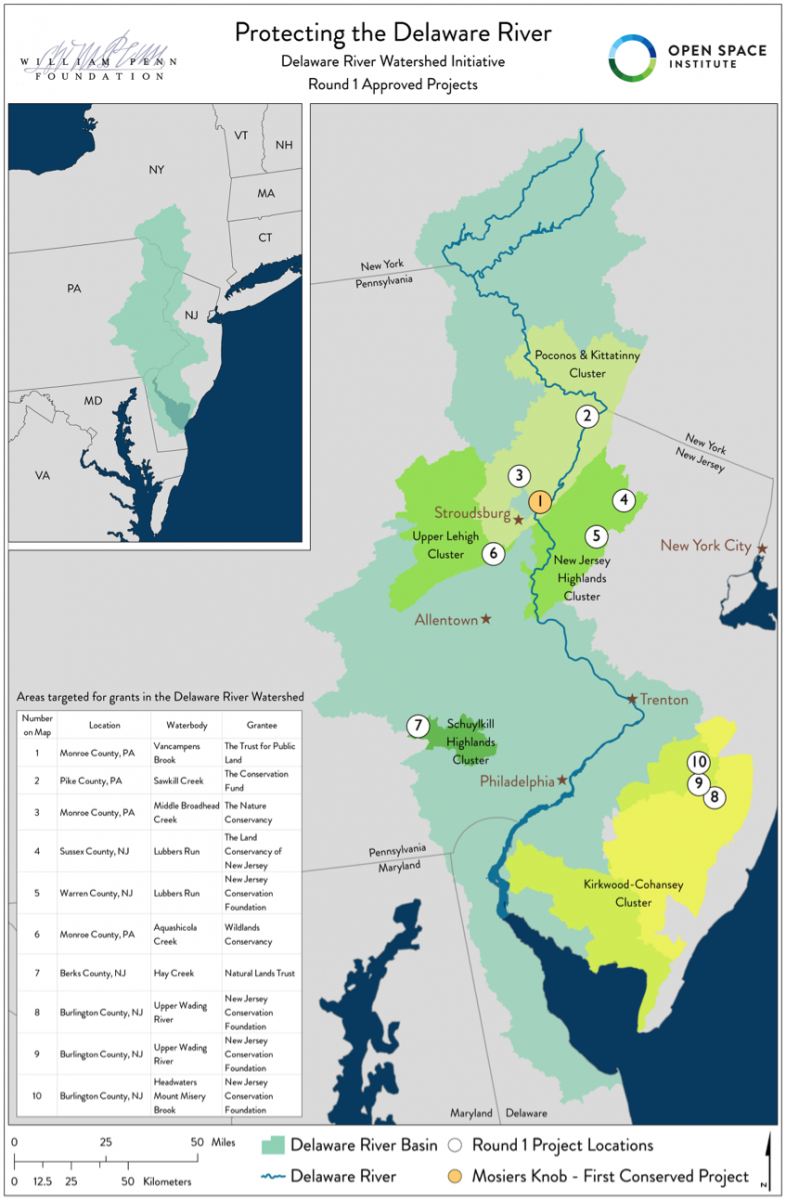More than 7,200 Acres of Land Identified for Protection within Delaware River Watershed, Directly Benefitting Drinking Water Quality for Region
Posted: Monday, April 20, 2015
Source:
William Penn Foundation
The William Penn Foundation and the Open Space Institute have announced the first in a series of land preservation projects intended to protect the drinking water supply for residents in the Delaware River Watershed. The suite of projects are all part of the Delaware River Watershed Initiative (DRWI), a multi-year, $35 million preservation plan, capitalized one year ago by the William Penn Foundation.
The 550-acre Mosiers Knob parcel is the first to be conserved of 10 projects to receive support in this inaugural round of grants (see map, p. 3) from the Open Space Institute (OSI), which received $9 million as part of the DRWI. The 10 projects, all situated within the Delaware River Watershed in Pennsylvania or New Jersey and located on lands that protect drinking water supply for millions of residents in the region, will collectively conserve approximately 7,200 acres of land in the watershed.
“Forests play a critical role in ensuring a reliable supply of clean water, in turn helping to meet human needs and strengthen our communities,” said Peter Howell, OSI’s Executive Vice President of Capital & Research Programs. “These projects protect important forestland and showcase the value of innovative and thoughtful collaborative initiatives in preserving water quality for millions of residents in the region.”
“The protection of land is critical to ensuring the future water quality of the Delaware River,” said Andrew Johnson, Watershed Protection Program Director at the William Penn Foundation. “Significant progress is being made, and it is exciting to see the momentum continue with this latest announcement.”
“The Delaware Water Gap National Recreation Area was established fifty years ago in response to public outcry against a major dam-building project that would have permanently impacted the Delaware River and surrounding communities,” said Anthony Cucchi, State Director for The Trust for Public Land. “Thanks to this innovative public-private partnership, we are pleased to be expanding upon that conservation legacy today to further protect our region’s water supply and natural heritage.”
Over the next three years, the DRWI will permanently protect more than 30,000 acres, implement more than 40 restoration projects, pilot new incentives for landowners and businesses, provide replicable models for other locations in the watershed, and develop long-term water quality data for the watershed at an unprecedented scale.
This inaugural round of grants alone will conserve 35 miles of stream bank, 2,000 acres of stream buffer, 4,300 acres of forests that are highly-capable of efficiently recharging depleted drinking water sources, and 1,000 acres that were highly vulnerable to development. Conserving land to protect the region’s water supply is one important strategy for protecting the region’s drinking water quality. Deforestation from commercial, residential, and energy development, chemical runoff from farms, and storm water runoff in cities severely threaten the health of the watershed.
Many of the projects provide additional benefits beyond ensuring clean water. Mosiers Knob, for instance, is also a highly climate-resilient landscape that will provide a refuge for wildlife in the face of a changing climate. OSI’s support for the project derived from two funds, with $240,000 from the Doris Duke Charitable Foundation to protect climate-resilient landscapes, and $350,000 from the DRWI.
The Delaware River Watershed covers more than 13,500-square miles spanning portions of New York, Pennsylvania, New Jersey and Delaware. In addition to being a major source of drinking water, the watershed supports an array of water-related economic enterprises valued at $25 billion per year, as well as hemispherically significant habitat.
Open Space Institute
The Open Space Institute protects scenic, natural and historic landscapes to provide public enjoyment, conserve habitat and working lands and sustain communities. Founded in 1974 to protect significant landscapes in New York State, OSI has been a partner in the protection of nearly 2.2 million acres in North America. A leader in environmental conservation, the Open Space Institute leverages our knowledge and attracts resources for strategic investments to make innovative land conservation happen. Visit the Open Space Institute online at www.osiny.org.
William Penn Foundation
The William Penn Foundation, founded in 1945 by Otto and Phoebe Haas, is dedicated to improving the quality of life in the Greater Philadelphia region through efforts that increase educational opportunities for children from low-income families, ensure a sustainable environment, foster creativity that enhances civic life, and advance philanthropy in the Philadelphia region. In partnership with others, the Foundation works to advance opportunity, ensure sustainability, and enable effective solutions. Since inception, the Foundation has made nearly 10,000 grants totaling over $1.6 billion. The Foundation’s assets exceed $2.3 billion as of March 31, 2015.
The Trust for Public Land
The Trust for Public Land creates parks and protects land for people, ensuring healthy, livable communities for generations to come. Nearly ten million people live within a one-half mile walk of a Trust for Public Land park, garden, or natural area, and millions more visit these sites every year. To support The Trust for Public Land and share why nature matters to you, visit www.tpl.org.
Figure 1 – A map showing the DRWI’s Round 1 approved projects. Shown on the map are some of the ecologically significant watershed cluster priority areas that the William Penn Foundation has identified for targeted grant-making and support.

